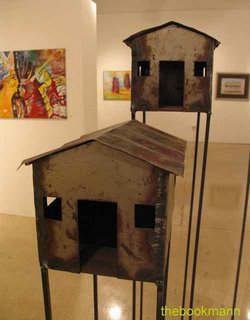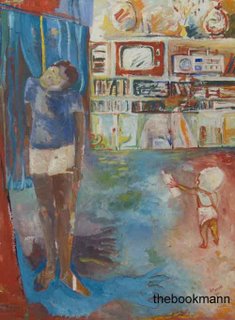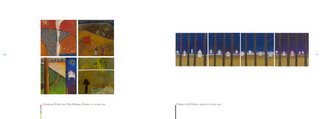
Inward Journey at National Museum, Trinidad and Tobago, West Indies
The National Museum in Port of Spain has produced a retrospective of the works of the artist Shastri Maharaj who has been practicing since the early 1970’s. Mr.Maharaj is arguably one of the few Indo-Trinbagonians working locally today in Trinidad and Tobago to that acclaimed. His art runs the gamut from Post Expressionism to Abstraction. I first came across Mr. Maharajs’ work in the mid 1980’s. I was very excited about his technical skill and moreso by his compositional creativity. At the time he was discussing things that were very current in his own life, things that were both intimate to him and humorous. I recall one piece where he painted a house with a veranda, and on the veranda was a frigerator.The house was his grandmothers’ and he had some funny antidotes about it. I recalled that I found his energy infectious and I thought that this artist is the locale quivalent of the luminaries that were being touted in America, Julien Schnabel, Sandro Chia and Francesco Clemente. His ideas seemed refreshing and even daring for our society.
I never promised you a Rose Garden
Over the years Mr.Maharaj’s concepts have not continued in the direction he began and I must say that I have occasionally been disappointed about that. He has meandered in the direction of Indocultural symbology, using a lot of imagery from a traditional Indian aesthetic. He has focused on the many layers of traditional Indian crafts in his work, and although this has been relatively new for an Indian artist working in Trinidad, (The late Dr.James Isaiah Boodhoo had the same introspection about being Indian and Indian life in terms of exploration) however in Mr. Maharaj’s case, I have found his work limiting interms of technique and content. Gone is the searching nature of colour. Gone is the almost manic desire to explore complexities of life. In its place are ideas outside of himself that seem too politically correct while adhering to what one expects of Indian concepts in our society today. I lament the retirement of the work he had first began with.
Ring De Bell
However this show put on by the museum has more serious concerns. A retrospective suggests a body of work that shows growth as well as process. In this attempt that is seen in the small annex space of the museum, there are no added pieces of literature on the artist other than some sketchbooks. I would have liked to have seen some writing on the artists process and a better variety of work. 
Deity on the cover of the The National Museum's Catalogue
As someone at the opening suggested, acquisitions from people who had purchased his work over the years should have been added the exhibition. Another curious thing is the price list accompanying the works on show? This makes the whole point of a retrospective seem like something else altogether. The pieces are not in any order of date and some of the works on closer inspection have come to the museum without any restoration or upkeep. One early piece in particular has dry rotted at its base. I was quite shocked to see it in such condition. This brings me to a statement that I must make about what is happening with Art in Trinidad and Tobago at this time that really concerns me. On the one hand I find that of late there have been many shows that attempt a sort of retrospective of known artists. I say attempt because these shows have all fallen flat in terms of preparation and presentation because of the sloppiness of the curation. I wonder how these shows happen? Do the people involved and this includes the artist, sit and discuss what they want to achieve from the showing? Do they actually go through the works and discuss content and context? Do they discuss lighting and framing? Do they discuss borrowing works and restoring? How is the whole thing really planned? 
Spread of Mr.Maharaj's Catalogue The National Museum of Trinidad and Tobago
I am very concerned about this trend. It is claimed that art is important to our society. Yet the shows are presented with very little regard for quality. Why is this? It is not as though doing them badly is any less time consuming and challenging than doing them well! Is it possible that those involved just do not understand what it really takes to put on a professional showing? What is most unfortunate of all is that what I am stating here is likely to be interpreted as bashing instead of what is intended which is a look at producing better, stronger shows that will benefit all involved at the end of the day. Nonetheless it has to be said because these shows shall continue and will forever seem less than they can be. .- Adele
Shastri Maharaj
Sunday, May 28, 2006
An Inward Journey - Shastri Maharaj
Subscribe to:
Post Comments (Atom)
Disclaimer:
Views expressed on thebookmann are not affiliated with any Art Organizations and an “Art Review” may be open to interpretation as it is an observation at face value.
Amendments to such articles if misleading or with grammatical errors shall be corrected accordingly.
All photographs, Feinin studies, accompanying quotes, articles and visual headers appearing on site are the exclusive property of Richard Bolai © 2004 - 2010 All Rights Reserved.
Any fare use is restricted without written permission
Amendments to such articles if misleading or with grammatical errors shall be corrected accordingly.
All photographs, Feinin studies, accompanying quotes, articles and visual headers appearing on site are the exclusive property of Richard Bolai © 2004 - 2010 All Rights Reserved.
Any fare use is restricted without written permission
1 comment:
Who knows where to download XRumer 5.0 Palladium?
Help, please. All recommend this program to effectively advertise on the Internet, this is the best program!
Post a Comment